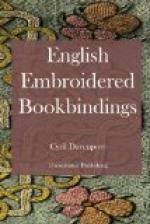Besides furnishing a ground for embroidery, velvet bindings were often decorated, in England, with goldsmith work. One of the most beautiful little bookcovers in existence is on a book of prayers, bound for Queen Elizabeth in red velvet, with a centre and corner pieces delicately enamelled on gold. Under the Stuarts, again, we frequently find similar ornaments in engraved silver, and their charm is incontestable.
Thus while for English bindings of this period in gilt leather we can only claim that Berthelet’s show some freedom in their adaptation of Italian models, and Day’s a more decided originality, we are entitled to set side by side with this scanty record a host of charming bindings in more feminine materials, which have no parallel in France, and certainly deserve some recognition. After the Restoration, however, leather quickly ousted its competitors, and a school of designers and gilders arose in England, which, while taking its first inspiration from Le Gascon, soon developed an individual style. In effectiveness, though not in minute accuracy of execution, this may rank with the best in Europe. We can trace the beginnings of this lighter and most graceful work as early as the thirties, and it might be contended with a certain plausibility that it began at the Universities. Certainly the two earliest examples known to me—the copy of her Statutes presented to Charles I. by Oxford in 1634, and the Little Gidding Harmony of 1635, the tools employed in which have been shown by Mr. Davenport to have been used also by Buck, of Cambridge—are two of the finest English bindings in existence, and in both cases, despite the multiplicity of the tiny tools employed, there is a unity and largeness of design which, as I have ventured to hint, is not always found even in the best French work. The chief English bindings after the Restoration,




